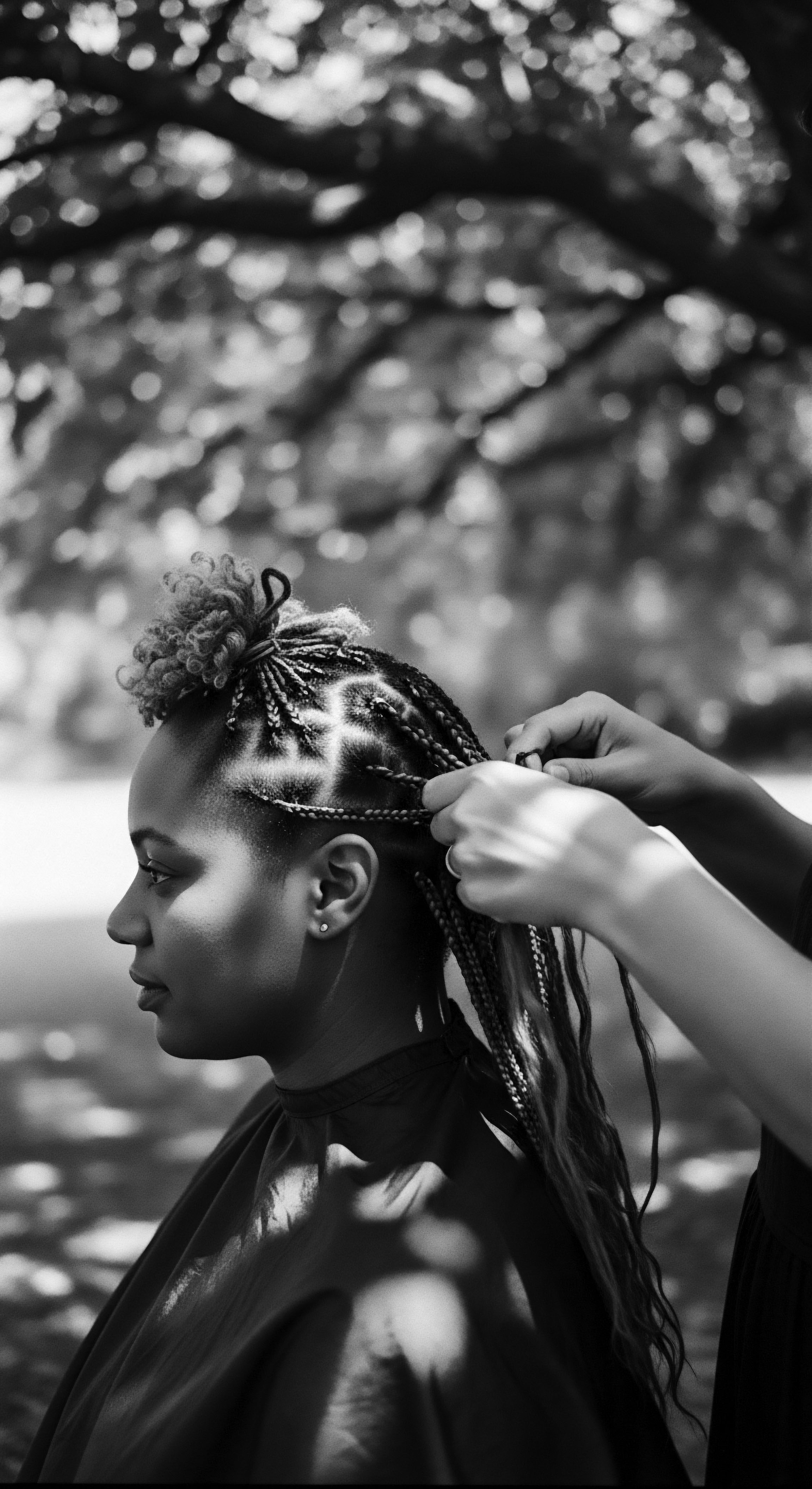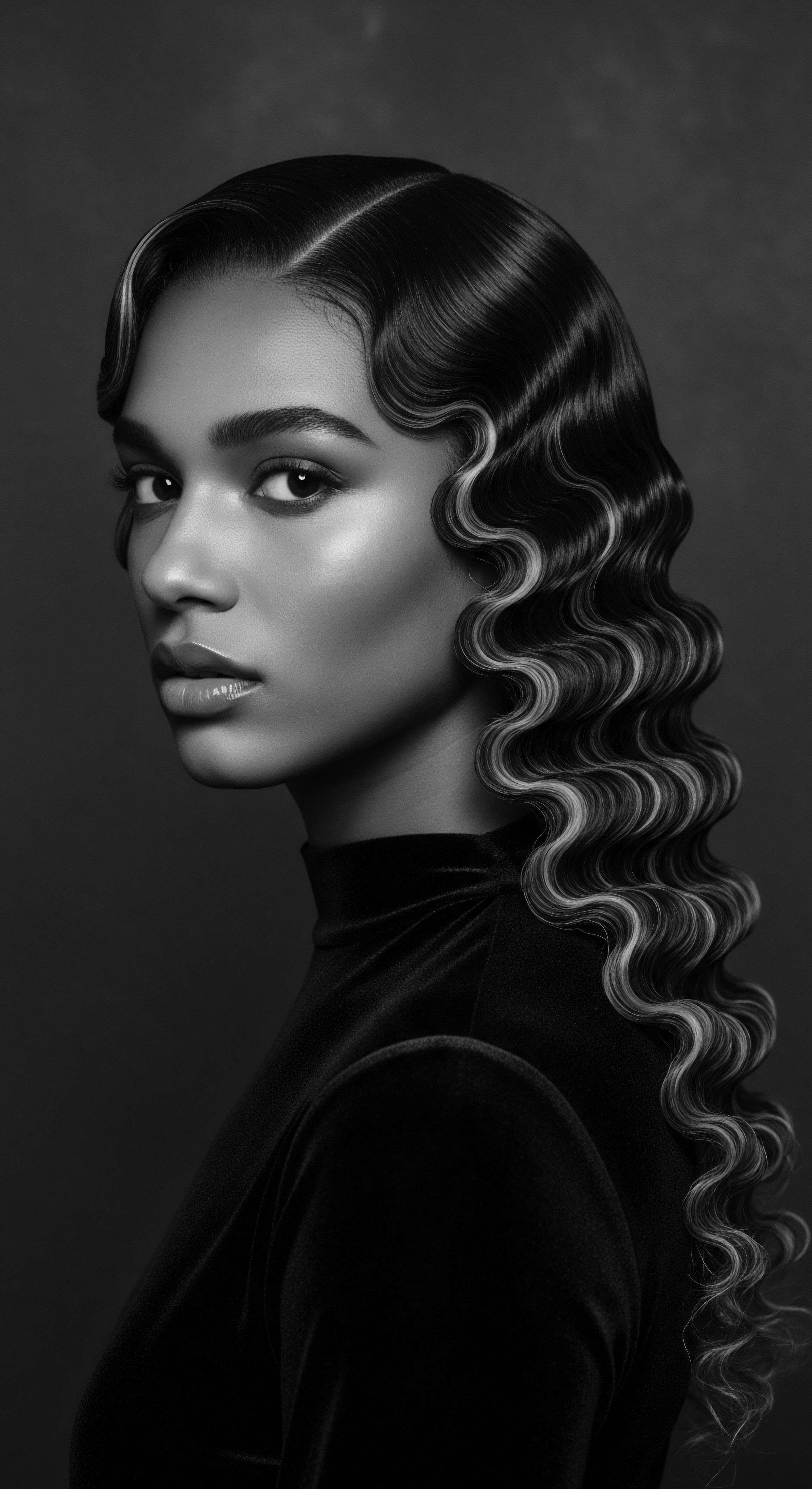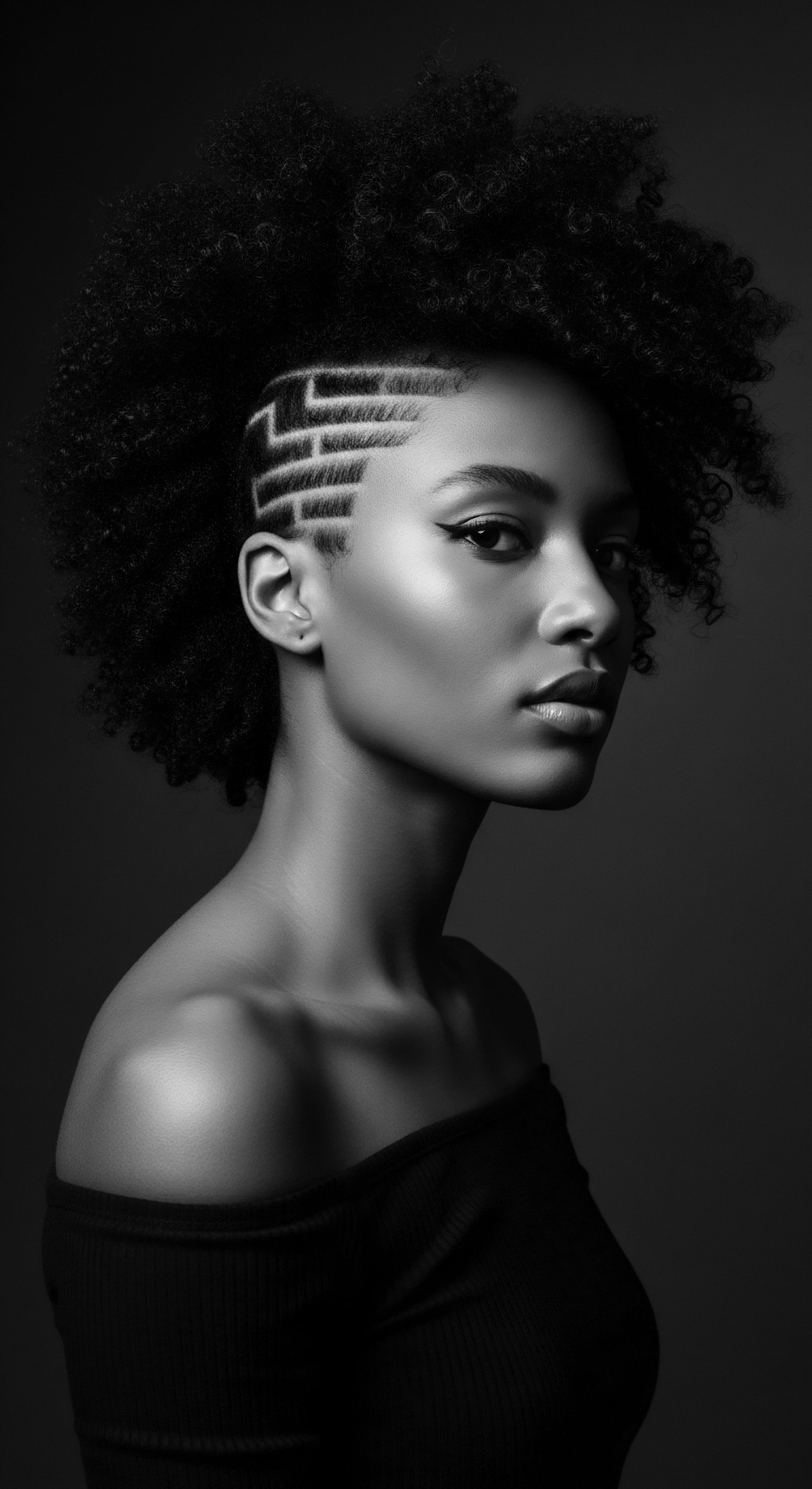
Roots
The very notion of hair care, particularly for textures that coil and curl with their own magnificent rhythm, reaches back into the deep wellspring of human story. It is a dialogue with ancient lands, with hands that knew the subtle secrets of the earth, and with whispers passed down through generations. To ask how cultural heritage shapes our modern hair oiling practices is to trace an ancestral map, to feel the resonance of ritual in the simple act of warming oil between palms.
For those whose strands bear the imprint of continents – Africa, the Caribbean, the Americas – this exploration is not a detached academic exercise. It marks a return, a listening to the echoes from the source, where the hair itself becomes a living archive, each strand a testament to resilience and wisdom.

The Architecture of Coil and Curl
Consider the biology, that elemental beginning. Textured hair, with its distinctive elliptical follicle shape, grows in a spiral or zig-zag pattern, creating a hair shaft that is not uniformly round but flattened or oval. This anatomical distinction means the cuticle layers, those protective shingles along the hair strand, do not lie as smoothly as on straight hair. The twists and turns create natural points of elevation, making it more challenging for natural scalp oils, or sebum, to descend consistently along the entire length of the strand.
This inherent characteristic renders textured hair more prone to dryness, requiring external lubrication. It is a biological reality that, from time immemorial, spurred human ingenuity and ancestral observation.
Long before the advent of modern microscopy, our forebears understood this intrinsic thirst. They did not parse the nuances of cuticle scales or protein bonds, yet their hands perceived the need for replenishment. The answer lay in the earth’s bounty ❉ the luscious fats from plants, the oils pressed from nuts and seeds. This intuitive understanding of hair’s fundamental requirements forms a bedrock of care, a foundation laid thousands of years ago.

A Nomenclature of Textures
Modern classification systems, with their numerical and alphabetical designations (like 3A, 4C), attempt to categorize the spectrum of textured hair. While these systems offer a contemporary language, they often overlook the richer, more nuanced ways communities historically described and understood hair’s diverse presentations. In many African cultures, hair types were not merely aesthetic categories; they were identifiers of lineage, social standing, age, and spiritual connection.
The way hair was oiled, styled, and adorned reflected these profound distinctions. A particular hair texture might call for a specific oil, perhaps one prized for its emollient properties, or another for its ability to lend a certain luster, thus enhancing a specific cultural expression.
The historical application of oils to textured hair emerges from a deep, intuitive understanding of its biological composition and its inherent need for profound moisture.

Cycles of Growth, Seasons of Care
The rhythm of hair growth, too, found its place within ancestral care. The anagen (growth), catagen (transition), and telogen (rest) phases were not named scientific terms, but their effects were certainly observed. Hair, like seasons, had its periods of vitality and shedding. Oiling practices were often continuous, a daily or weekly ritual, recognizing the hair’s ongoing need for fortification and protection.
Communities understood that consistent application nurtured growth and preserved the hair that had already flourished. The oils were not merely surface-level emollients; they were understood to be fortifying agents, working with the hair’s natural life cycle to promote its health and longevity.
Across various regions, the approach to hair oiling adapted to prevailing climates and available resources. In humid equatorial zones, lighter oils might have been favored for daily application, while in arid regions, denser, more protective balms were paramount. This adaptive brilliance speaks to a knowledge system that respected both the internal biology of the hair and the external conditions of its environment, a truly holistic perspective on well-being that prioritized the hair’s sustained strength.

Ritual
The hands that carefully parted hair and smoothed in rich oils were not merely performing a task; they were engaging in a dialogue, a transmission of wisdom and care that extended beyond the immediate physical act. Hair oiling, then and now, forms a central pillar of the enduring rituals that define textured hair care. It is an art, a science, and a profound expression of self and community, with practices that have journeyed across oceans and generations, adapting yet retaining their essential purpose.

Protective Styling Ancestral Roots
Consider the ancient art of protective styling, a hallmark of textured hair traditions. Braids, twists, and coils, often elaborately constructed, served not only aesthetic purposes but also shielded delicate strands from environmental stressors. Oiling played a critical role here, providing the necessary slip for intricate sectioning, minimizing friction during the styling process, and ensuring the scalp and hair remained hydrated beneath the protective shell of the style. Long before the modern term “protective style” existed, communities employed ingenious methods to preserve hair length and vigor, often beginning with a thorough application of oils.
- Castor Oil ❉ Widely used in West African and Afro-Caribbean communities, it was often applied to the scalp to encourage growth and strengthen hair, particularly before intricate braiding.
- Shea Butter ❉ A staple in many parts of West Africa, its thick consistency protected hair from harsh elements, acting as a sealant for styles that would last weeks or months.
- Palm Oil ❉ In certain regions, its rich orange hue not only nourished but could also impart a subtle color to hair, indicating status or tribal affiliation.

Defining the Natural Presentation
The embrace of natural texture, celebrated in contemporary times, holds deep historical precedent. Prior to colonial influences that often coerced the adoption of Eurocentric beauty standards, the natural coil and curl were revered. Oils were essential in coaxing definition from these textures, providing moisture that allowed curls to clump and present their true pattern, reducing frizz, and imparting a healthy sheen.
The application could be a morning ritual, a simple smoothing of oil to refresh a set style, or part of a more extensive wash-day routine. The goal was to nourish and accentuate the hair’s inherent beauty, allowing its unique spiral to unfurl with vitality.

Adornment and Transformation
The practice of adorning hair with extensions and wigs also traces back to antiquity, particularly in various African civilizations. These were not merely fashion statements; they were often symbols of royalty, spiritual connection, or marital status. When utilizing these transformative elements, the underlying hair and scalp still required diligent care.
Oils were applied to the natural hair before extensions were added, or to the scalp beneath wigs, preventing dryness, irritation, and breakage. This ensured that the foundation remained healthy, allowing for the periodic removal and reapplication of adornments without compromising the hair’s integrity.
| Aspect Primary Goal |
| Ancestral Practice Nourishment, protection, spiritual connection, cultural identity |
| Modern Application Moisture retention, scalp health, styling aid, damage prevention |
| Aspect Typical Source |
| Ancestral Practice Locally harvested botanical fats and oils (e.g. shea, coconut, palm) |
| Modern Application Botanical oils (often global sourcing), synthetic compounds, specialized blends |
| Aspect Application Context |
| Ancestral Practice Daily routine, ceremonial rites, communal grooming, preparation for protective styles |
| Modern Application Wash days, styling, scalp treatments, pre-poo, deep conditioning |
| Aspect The enduring wisdom of ancestral oiling practices continues to inform and enrich contemporary textured hair care, bridging past and present. |

Heat and Its Historical Counterparts
The use of heat in styling, while often associated with modern tools, has historical parallels, such as the hot comb. When such methods were employed, oils served as a crucial buffer. They offered a layer of protection against the intense heat, helping to prevent singeing and excessive dryness.
This historical application foreshadows modern thermal protectants, demonstrating an early understanding of the need to shield hair from potential damage. The wisdom lay in mitigating the harsh effects of external forces on delicate hair, a principle that remains central to care today.
Oiling rituals, from ancient protective styling to modern moisture preservation, serve as a testament to the enduring ingenuity of textured hair care.

The Hair Toolkit Across Time
The tools accompanying hair oiling practices have also evolved, yet their essential purpose remains. Ancient combs carved from wood or bone, simple fingers, and later, specialized implements like hair picks, all worked in concert with oils to detangle, distribute product, and sculpt hair. The rhythmic motion of oiling and combing, often a shared activity among women, solidified bonds, transmitted skills, and preserved knowledge. The efficacy of the oil was enhanced by the gentle, deliberate action of application, turning a functional need into a tender ritual.

Relay
The relay of knowledge, from elder to youth, from ancestral memory to present-day practice, forms the living current of textured hair care. Here, the profound wisdom of cultural heritage meets contemporary understanding, weaving a comprehensive narrative of hair oiling that transcends simple utility. It delves into the intricate interplay of botanical gifts, spiritual resonance, and communal well-being, all seen through the unique lens of heritage. The practices we observe today are not simply modern innovations; they are often echoes, refined and reinterpreted, of traditions that have sustained communities for centuries.

Crafting Personalized Regimens
The contemporary emphasis on personalized hair care regimens, tailored to individual needs, finds a compelling parallel in ancestral wisdom. Traditional hair care was never a one-size-fits-all proposition. It was rooted in a deep understanding of unique hair types within a family or community, often passed down as bespoke advice. The selection of specific oils, or blends of oils, was guided by observed needs ❉ a lighter oil for fine coils, a heavier balm for dense, coarse textures, or particular herbs infused for scalp health.
This ancestral approach, which prioritized listening to the hair and scalp, directly informs the modern movement toward individualized routines. It is a testament to the intuitive scientific understanding embedded within traditional practices, where observation and adaptation were paramount.
Consider the meticulous care involved in preparing traditional oil infusions. In many West African societies, the making of shea butter, for instance, involved collective effort and precise techniques to yield a pure, nourishing product. This process, spanning harvesting, cracking, roasting, and kneading, was not merely industrial; it was a communal rite, imbued with intention and generational knowledge. The resulting butter, rich in vitamins and fatty acids, was then applied with purpose, demonstrating a holistic appreciation for the entire life cycle of the ingredient, from earth to hair.

The Nighttime Sanctuary and Bonnet Wisdom
The nighttime protection of hair, now commonly associated with satin bonnets and scarves, carries a long and significant lineage. While modern materials offer specific advantages, the underlying principle of preserving hair during sleep is ancient. In many historical African societies, hair was often elaborately styled for daytime presentation, and then carefully wrapped or covered at night to protect the integrity of these intricate designs and prevent damage. This foresight protected the hair from tangling, friction, and moisture loss against coarse sleeping surfaces.
The bonnet, therefore, is not merely a modern accessory; it is a direct descendant of ancestral practices, a continuation of care that ensures the labor of daytime styling and oiling is not undone by rest. Oils applied before wrapping enhanced this protective barrier, sealing moisture into the strands, thus aiding in curl definition and preventing breakage while the body rejuvenated.
The journey of hair oiling from ancient rituals to modern routines represents a continuous flow of ancestral wisdom, adapting to new contexts while retaining its core purpose.

Potent Ingredients and Cultural Narratives
The diverse array of oils employed in modern textured hair care directly connects to a legacy of botanical wisdom. Each oil often carries its own cultural narrative, its uses refined over centuries within specific geographical and communal contexts.
- Coconut Oil ❉ A cornerstone in many Afro-Caribbean and Pacific Islander hair traditions, recognized for its ability to penetrate the hair shaft. Its cultural importance extends to food, medicine, and spiritual rites, making its application to hair a profoundly connected act.
- Moringa Oil ❉ Prized in parts of Africa and India, it is often referred to as a “miracle tree.” Its oil, rich in antioxidants, has been used for generations to nourish scalp and hair, reflecting a deep indigenous knowledge of local flora for wellness.
- Jojoba Oil ❉ While perhaps more widely popularized in recent decades, its composition closely mimics the scalp’s natural sebum, making it a valuable emollient, echoing the natural balance sought in ancestral care.
Consider the profound role of Shea Butter in West African heritage. Its extraction and use are deeply embedded in the economic, social, and cultural fabric of communities across the Sahelian belt. Women, often organized into collectives, harvest the shea nuts, transforming them through a labor-intensive process into the creamy butter. This butter, beyond its economic value, has been a generations-long staple for skin and hair care, particularly for textured hair.
Its efficacy in sealing moisture, preventing breakage, and soothing scalps is not a recent discovery; it is knowledge preserved through countless applications. For example, anthropologist Louise M. Sperling observed the intricate economic and social structures built around shea production in Mali, noting its pervasive use in daily life, including extensive applications for hair and skin, reinforcing its status as an invaluable ancestral resource (Sperling, 2001). This deeply ingrained use transcends mere cosmetic application, reaching into the spiritual and communal life, signifying an unbroken chain of wellness and beauty practices.

Problem Solving Through Ancient Wisdom
Many common textured hair concerns – dryness, breakage, scalp irritation, lack of definition – are not new phenomena. Ancestral practices evolved precisely to address these challenges, with hair oils at the forefront of the solutions. Oils were applied to parched strands to restore suppleness, massaged into scalps to soothe discomfort and stimulate growth, and used to provide the necessary lubrication for detangling, thereby minimizing breakage. The continuity of these problems, and the continuity of oils as a primary solution, speaks to a timeless wisdom.
Modern problem-solving in textured hair care often revisits these foundational principles, sometimes validating ancient remedies with contemporary scientific understanding of lipid profiles or anti-inflammatory properties. The efficacy of, say, castor oil for thinning edges, often dismissed as folk wisdom, now finds support in its ricinoleic acid content, which may promote circulation and nutrient delivery to hair follicles.

Holistic Wellness and the Hair
Beyond the physical attributes, hair oiling in many cultures was, and remains, an integral aspect of holistic well-being. It was often a moment of self-care, a meditative pause, or a communal activity that fostered bonds. The belief in the hair as a conduit for spiritual energy, or as a repository of personal strength and lineage, elevated its care beyond simple aesthetics.
Oiling became a way of honoring the self, connecting to one’s roots, and maintaining a sense of balance. This deep-seated philosophical approach to hair health, viewing it as inseparable from the body and spirit, continues to permeate modern wellness dialogues surrounding textured hair, reminding us that its care extends far beyond superficial appearance.

Reflection
The journey through the intricate world of hair oiling for textured hair reveals more than just techniques and ingredients; it uncovers a profound historical dialogue. Each drop of oil smoothed onto a coil or curl carries the memory of countless hands that performed the same tender act across millennia. It represents an unbroken thread of ancestral wisdom, a living archive where scientific understanding and deep cultural meaning converge. The contemporary resurgence of interest in natural hair care and traditional practices is not a trend; it is a powerful reclamation of heritage, a return to the essence of what it means to honor one’s strands as an extension of self, community, and lineage.
As we continue to explore the nuances of textured hair care, the ‘Soul of a Strand’ ethos reminds us that every fiber holds a story. Hair oiling, in its modern iteration, stands as a vibrant testament to enduring ingenuity, adaptability, and the timeless pursuit of well-being that has long defined textured hair communities. It is a practice that continues to nourish not only the hair itself, but also the spirit connected to its rich, storied past.

References
- Sperling, Louise M. (2001). Shea Nut and Butter in Rural West Africa ❉ Field Notes from Mali. International Network for Bamboo and Rattan.
- Boateng, J. S. et al. (2017). “Shea Butter (Vitellaria paradoxa) as a Base for Topical Formulations ❉ A Review.” Journal of Pharmaceutical and Biomedical Analysis.
- Robbins, C. R. (2012). Chemical and Physical Behavior of Human Hair. Springer.
- Byrd, A. S. & Tharps, L. D. (2001). Hair Story ❉ Untangling the Roots of Black Hair in America. St. Martin’s Press.
- Akerele, O. (1991). “Medicinal Plants and Traditional Medicine in Africa.” Journal of Ethnopharmacology.
- Opoku, A. (2014). “The Cultural Significance of Traditional African Hairstyles.” International Journal of Humanities and Social Science.
- Gbedema, S. Y. et al. (2014). “Traditional Uses of Oils in Ghana for Hair and Skin Care.” African Journal of Traditional, Complementary and Alternative Medicines.
